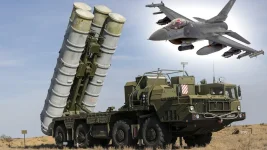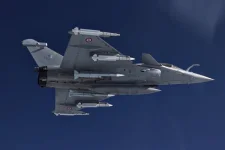Reports indicate the Pakistan Air Force (PAF) has undertaken a significant strategic repositioning, moving approximately half of its advanced F-16 Block 52+ fighter jets to Pasni Airfield. This base is located near Gwadar in Pakistan's Balochistan province, situated on the coast of the northern Arabian Sea.
This relocation is widely interpreted as a defensive manoeuvre designed to position these valuable aircraft outside the surveillance and engagement range of India’s recently acquired S-400 Triumf air defence systems.
India's integration of the Russian-developed S-400 system, globally recognised as one of the most potent long-range air defence platforms, has fundamentally altered the air power equation in South Asia.
The S-400 possesses extensive radar coverage and long-distance missile capabilities, enabling it to monitor and potentially target aircraft deep within neighbouring airspace.
This capability effectively creates a robust anti-access/area-denial (A2/AD) zone, significantly complicating air operations for potential adversaries near Indian borders. India began receiving deliveries of the S-400 system in late 2021.
Recent combat experiences, particularly in the Ukraine conflict, have likely influenced Pakistan's decision. Observations from Ukraine suggest that even modern Western aircraft may face significant challenges against sophisticated air defence systems like the S-400.
Despite upgrades, aircraft like the F-16 are reportedly vulnerable to the S-400's capacity to detect and intercept targets, including low-flying aircraft, from extended ranges potentially exceeding 400 kilometres, especially when the system operates in tandem with airborne early warning aircraft.
Consequently, the perceived threat from India's S-400 deployment has seemingly prompted the PAF to reconsider the basing strategy for its premier fighter assets, the F-16 Block 52+ fleet.
By transferring a substantial number of these jets to Pasni, the PAF aims to shield them from the reach of S-400 batteries deployed in India's western regions, notably Rajasthan and Gujarat, which border Pakistan.
The Pasni Airfield offers distinct geographical advantages for this purpose. Its location, further southwest compared to many traditional PAF operational bases situated closer to the Indian border, provides greater strategic depth and relative safety from immediate threats.
Its proximity to the Arabian Sea also facilitates wider dispersal options in a crisis scenario, potentially making PAF assets harder to track and target.
While this relocation can be viewed as a cautious measure to safeguard critical air power resources, it also highlights the strategic pressure Pakistan faces due to India's strengthening air defence network.
Shifting frontline fighters away from the immediate border regions could potentially limit the PAF's ability to project air power rapidly should hostilities arise along the India-Pakistan Line of Control or international border.
Ultimately, this redeployment underscores the significant deterrent effect of India's S-400 systems. Their presence not only bolsters India's air defence but also compels neighbouring air forces to adopt more defensive postures, thereby influencing their operational flexibility and strategic calculations.







